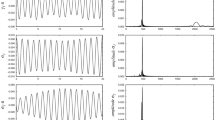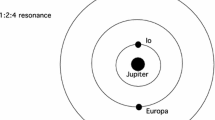Abstract
The nonlinearities of the dynamics of Earth artificial satellites are encapsulated by two formal integrals that are customarily computed by perturbation methods. Standard procedures begin with a Hamiltonian simplification that removes non-essential short-period terms from the Geopotential, and follow with the removal of both short- and long-period terms by means of two different canonical transformations that can be carried out in either order. We depart from the tradition and proceed by standard normalization to show that the Hamiltonian simplification part is dispensable. Decoupling first the motion of the orbital plane from the in-plane motion reveals as a feasible strategy to reach higher orders of the perturbation solution, which, besides, permits an efficient evaluation of the long series that comprise the analytical solution.









Similar content being viewed by others
Notes
The advantages of decoupling the motion of the instantaneous orbital plane from the in-plane motion are well known and are commonly pursued in the search for efficient numerical integration methods, q.v. [43] and references therein.
References
Aksnes, K.: A note on ‘The main problem of satellite theory for small eccentricities, by A. Deprit and A. Rom, 1970’. Celest. Mech. 4(1), 119–121 (1971)
Alfriend, K.T., Coffey, S.L.: Elimination of the perigee in the satellite problem. Celest. Mech. 32(2), 163–172 (1984)
Arnol’d, V.I.: Mathematical Methods of Classical Mechanics, volume 60 of Graduate Texts in Mathematics. 2nd ed., Springer, New York (1989)
Breakwell, J.V., Vagners, J.: On error bounds and initialization in satellite orbit theories. Celest. Mech. 2, 253–264 (1970)
Broucke, R.A.: Numerical integration of periodic orbits in the main problem of artificial satellite theory. Celest. Mech. Dyn. Astron. 58(2), 99–123 (1994)
Brouwer, D.: Solution of the problem of artificial satellite theory without drag. Astron. J. 64, 378–397 (1959)
Brouwer, D., Clemence, G.M.: Methods of Celestial Mechanics. Academic Press, New York (1961)
Celletti, A., Negrini, P.: Non-integrability of the problem of motion around an oblate planet. Celest. Mech. Dyn. Astron. 61(3), 253–260 (1995)
Coffey, S.L., Deprit, A.: Third-order solution to the main problem in satellite theory. J. Guid. Control Dyn. 5(4), 366–371 (1982)
Coffey, S.L., Deprit, A., Miller, B.R.: The critical inclination in artificial satellite theory. Celest.l Mech. 39(4), 365–406 (1986)
Cook, R.A.: The long-term behavior of near-circular orbits in a zonal gravity field (AAS 91-463). In Kaufman, B., Alfriend, K.T., Roehrich, R.L., Dasenbrock, R.R. (eds) Astrodynamics 1991, volume 76 of Advances in the Astronautical Sciences, American Astronautical Society, Univelt, Inc, pp. 2205–2221 (1992)
Danby, J.M.A.: Motion of a satellite of a very oblate planet. Astron. J. 73(10), 1031–1038 (1968)
Danby, J.M.A.: Fundamentals of Celestial Mechanics, 2nd edn. Willmann-Bell, Richmond VA (1992)
Delaunay, C.E.: La Théorie du Mouvement de la Lune, Premier volume. Mémoires de l’Academie des Sciences de l’Institut Impérial de France, vol. 28. Mallet-Bachellier, Paris (1860)
Deprit, A.: Canonical transformations depending on a small parameter. Celest. Mech. 1(1), 12–30 (1969)
Deprit, A.: The elimination of the parallax in satellite theory. Celest. Mech. 24(2), 111–153 (1981)
Deprit, A.: Delaunay normalisations. Celest. Mech. 26, 9–21 (1982)
Deprit, A., Miller, B.: Simplify or Perish. Celest. Mech. 45, 189–200 (1989)
Deprit, A., Rom, A.: The main problem of artificial satellite theory for small and moderate eccentricities. Celest. Mech. 2(2), 166–206 (1970)
Frauenholz, R.B., Bhat, R.S., Shapiro, B.E., Leavitt, R.K.: Analysis of the TOPEX/poseidon operational orbit: observed variations and why. J Spacecr Rock 35, 212–224 (1998)
Gaias, G., Colombo, C., Lara, M.: Analytical framework for precise relative motion in low earth orbits. J. Guid. Control Dyn, 1–13, (2020)
Goldstein, H., Poole, C.P., Safko, J.L.: Classical Mechanics, 3rd edn. Addison-Wesley, New York (2001)
Hansen, P.A.: Expansions of the product of a power of the radius vector with the sinus or cosinus of a multiple of the true anomaly in terms of series containing the sinuses or cosinuses of the multiples of the true, eccentric or mean anomaly. Abhandlungen der Koniglich Sachsischen Gesellschaft der Wissenschaften 2(3), 183–281 (1855). English translation by J.C. Van der Ha, ESA/ESOC, Darmstadt, Germany, 1977
Hautesserres, D., Lara, M.: Intermediary LEO propagation including higher order zonal harmonics. Celest. Mech. Dyn. Astron. 127, 505–526 (2017)
Healy, L.M.: The Main Problem in Satellite Theory Revisited. Celest. Mech. Dyn. Astron. 76(2), 79–120 (2000)
Irigoyen, M., Simo, C.: Non integrability of theJ \(_{2}\) problem. Celest. Mech. Dyn. Astron. 55(3), 281–287 (1993)
Izsak, I.G.: A second-order solution of vinti’s dynamical problem. Smithsonian Contribut. Astrophys. 6, 81–107 (1963)
Jefferys, W.H.: Automated, closed form integration of formulas in elliptic motion. Celest. Mech. 3, 390–394 (1971)
Jupp, A.H.: The critical inclination problem - 30 years of progress. Celest. Mech. 43(1–4), 127–138 (1988)
Kahan, W.: Lecture notes on the status of IEEE standard 754 for binary floating-point arithmetic. Technical report, Electrical Engineering and Computer Science, University of California, Berkeley, CA, October (1997)
Kaula, W.M.: Analysis of gravitational and geometric aspects of geodetic utilization of satellites. Geophys. J 5, 104–133 (1961)
Kinoshita, H.: First-order perturbations of the two finite body problem. Publ. Astronom. Soc. Jpn. 24, 423–457 (1972)
Kinoshita, H.: Third-order solution of an artificial-satellite theory. SAO Special Report, 379, (1977)
Konopliv, A.: A perturbation method and some applications. Celest. Mech. Dyn. Astron. 47, 305 (1990)
Konopliv, A.S.: A third order of \(J_2\) solution with a transformed time. Interoffice Memorandum IOM 314.3 - 970, Jet Propulsion Laboratory, 4800 Oak Grove Dr, Pasadena, CA 91109, USA, March (1991)
Kozai, Y.: The motion of a close earth satellite. Astronom. J. 64, 367–377 (1959)
Kozai, Y.: Second-order solution of artificial satellite theory without air drag. Astronom. J. 67, 446–461 (1962)
Lara, M.: SADSaM: A software assistant for designing satellite missions. Technical Report DTS/MPI/MS/MN/99-053, Centre National d’Études Spatiales, 18, avenue Edouard Belin - 31401 Toulouse Cedex 9, France, May (1999)
Lara, M.: Searching for repeating ground track orbits: a systematic approach. J Astronaut. Sci. 47(3–4), 177–188 (1999)
Lara, M.: Simplified equations for computing science orbits around planetary satellites. J. Guid. Control Dyn. 31(1), 172–181 (2008)
Lara, M.: On inclination resonances in artificial satellite theory. Acta Astronaut. 110, 239–246 (2015). Dynamics and Control of Space Systems
Lara, M.: Analytical and semianalytical propagation of space orbits: the role of polar-nodal variables. In Gómez, G., Josep M.J. (eds) Astrodynamics Network AstroNet-II: The Final Conference, volume 44 of Astrophysics and Space Science Proceedings, pp. 151–166. Springer, Cham (2016)
Lara, M.: Note on the ideal frame formulation. Celest. Mech. Dyn. Astron. 129, 137–151 (2017)
Lara, M.: Nonlinear librations of distant retrograde orbits: a perturbative approach–the Hill problem case. Nonlinear Dyn. 93(4), 2019–2038 (2018)
Lara, M.: A new radial, natural, higher-order intermediary of the main problem four decades after the elimination of the parallax. Celest. Mech. Dyn. Astron. 131(9), 20 (2019)
Lara, M., Ferrer, S.: Closed form perturbation solution of a fast rotating triaxial satellite under gravity-gradient torque. Cosm. Res. 51(4), 289–303 (2013)
Lara, M., Ferrer, S.: Expanding the simple pendulum’s rotation solution in action-angle variables. Eur. J. Phys. 36(5), 055040 (2015). Expanded version: arXiv eprint nlin.SI 1503.03358
Lara, M., San-Juan, J.F., López-Ochoa, L.M.: Delaunay variables approach to the elimination of the perigee in Artificial Satellite Theory. Celest. Mech. Dyn. Astron. 120(1), 39–56 (2014)
Lara, M., San-Juan, J.F., López-Ochoa, L.M.: Proper averaging via parallax elimination (AAS 13-722). In: Broschart, S.B., Turner, J.D., Howell, K.C., Hoots, F.R. (eds.) Astrodynamics 2013, volume 150 of Advances in the Astronautical Sciences, pages 315–331, P.O. Box 28130, San Diego, California 92198, USA, January. American Astronautical Society, Univelt, Inc (2014)
Lara, M., San-Juan, J.F., Hautesserres, D.: Semi-analytical propagator of high eccentricity orbits. Technical Report R-S15/BS-0005-024, Centre National d’Études Spatiales, 18, avenue Edouard Belin - 31401 Toulouse Cedex 9, France, January (2016)
Lara, M., Vilhena de Moraes, R., Sanchez, D.M., Prado, A.F.B.A.: Efficient computation of short-period analytical corrections due to third-body effects (AAS 15-295). In: Furfaro, R., Casotto, S., Trask, A., Zimmer, S. (eds) AAS/AIAA Spaceflight Mechanics Meeting 2015, volume 155 of Advances in the Astronautical Sciences, USA, 2015. American Astronautical Society, Univelt, Inc, pp. 437–455 (2015)
Lyddane, R.H.: Small eccentricities or inclinations in the Brouwer theory of the artificial satellite. Astron. J. 68(8), 555–558 (1963)
Metris, G.: Mean values of particular functions in the elliptic motion. Celest. Mech. Dyn. Astron. 52, 79–84 (1991)
Nayfeh, A.H.: Perturbation Methods. Wiley-VCH Verlag GmbH & Co. KGaA, Weinheim (2004)
Osácar, C., Palacián, J.F.: Decomposition of functions for elliptical orbits. Celest. Mech. Dyn. Astron. 60(2), 207–223 (1994)
Persson, S., Jacobsson, B., Gill, E.: PRISMA–Demonstration Mission for Advanced Rendezvous and Formation Flying Technologies and Sensors (paper IAC-05-B56B07). In: Proceedings of the 56th International Astronautical Congress (IAC), October 17–21 2005, Fukuoka, Japan, pages 1–10. International Astronautical Federation (IAF), International Astronautical Federation (IAF), October (2005)
Sabol, C., Draim, J., Cefola, P.J.: Refinement of a sun-synchronous, critically inclined orbit for the \(\text{ ELLIPSO}^{{\rm TM}}\) personal communication system. J. Astronaut. Sci. 44, 467–489 (1996)
San-Juan, J.F., Ortigosa, D., López-Ochoa, L.M., López, R.: Deprit’s elimination of the parallax revisited. J. Astronaut. Sci. 60, 137–148 (2013)
Tisserand, F.: Traité de mécanique céleste. Tome I: Perturbations des planètes d’aprés la méthode de la variation des constantes arbitraries. Gauthier-Villars et fils, Quai des Grands-Augustins, 55, Paris (1889)
Acknowledgements
Support by the Spanish State Research Agency and the European Regional Development Fund under Projects ESP2016 -76585-R and ESP2017-87271-P (MINECO/ AEI/ERDF, EU) is recognized.
Author information
Authors and Affiliations
Corresponding author
Ethics declarations
Conflict of interest
The author declares that he has no conflict of interest.
Additional information
Publisher's Note
Springer Nature remains neutral with regard to jurisdictional claims in published maps and institutional affiliations.
Appendix: Tables of inclination polynomials
Appendix: Tables of inclination polynomials
Inclination polynomials needed in the evaluation of the analytical perturbation solution up to the third order of \(J_2\) are summarized in this appendix.
Rights and permissions
About this article
Cite this article
Lara, M. Solution to the main problem of the artificial satellite by reverse normalization. Nonlinear Dyn 101, 1501–1524 (2020). https://doi.org/10.1007/s11071-020-05857-3
Received:
Accepted:
Published:
Issue Date:
DOI: https://doi.org/10.1007/s11071-020-05857-3




